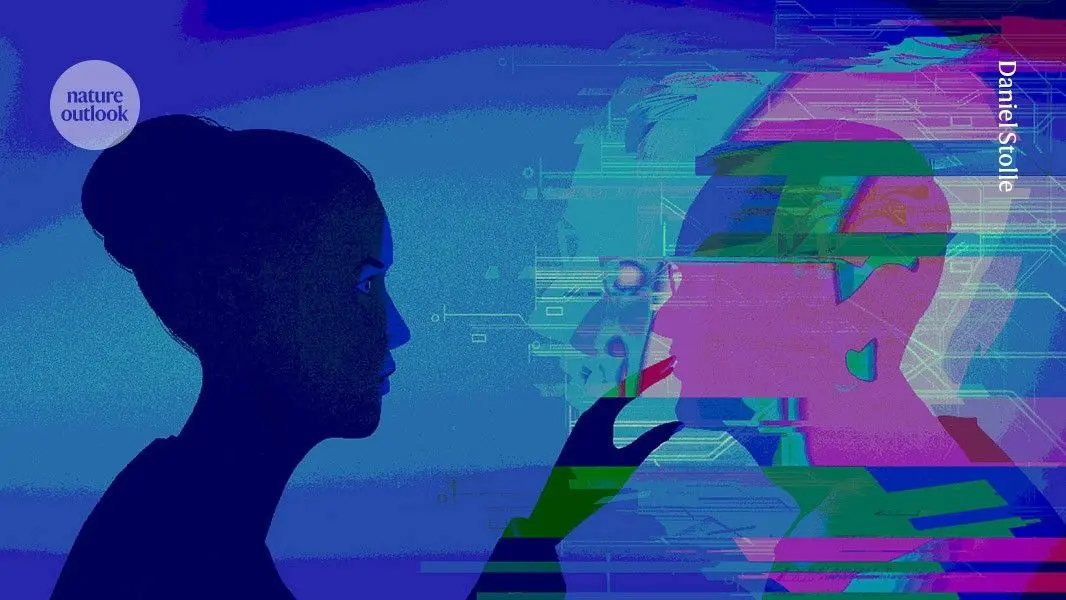Buddhism Cautions Against AI Avatars of the Deceased: A Perspective on Grief and Technology
3 Sources
3 Sources
[1]
It is becoming easier to create AI avatars of the deceased - here is why Buddhism would caution against it
Elaine Lai does not work for, consult, own shares in or receive funding from any company or organisation that would benefit from this article, and has disclosed no relevant affiliations beyond their academic appointment. In a story in the Buddhist canon, a grief-stricken mother named Kisa Gautami loses her only child and carries the body around town, searching for some way to resurrect the child. When she encounters the Buddha, he asks her to collect several mustard seeds from a family that has never experienced death. Not surprisingly, Kisa Gautami is unable to find a single such family. She buries her child and decides to cultivate a spiritual life. I thought of Kisa Gautami's story when I first encountered the 2020 Korean documentary "Meeting You," in which virtual reality technology is used to reunite a grieving mother, Jang Ji-sung, with her deceased 7-year-old daughter, Nayeon. While the virtual reunion was moving to witness, I wondered whether it was truly helping the mother to heal, or whether it was deepening an avoidance of grief and of the truth. Since the documentary first aired, the business of digitally resurrecting the deceased has grown significantly. People are now using AI to create "grief bots," which are simulations of deceased loved ones that the living can converse with. There has even been a case where an AI-rendered video of a deceased victim has appeared to deliver a court statement asking for the maximum sentence for the person who took their life. As a Buddhist studies scholar who has experienced several bereavements this year, I have turned to Buddhist teachings to reflect on how creating a digital afterlife for loved ones may inadvertently enhance our suffering, and what alternative ways of grieving Buddhism might offer. Buddhism's view on suffering According to Buddhist thought, the root of all suffering is clinging to illusions. This clinging creates karma that perpetuates negative cycles - for oneself and others - which endure lifetimes. In Mahayana Buddhism, the path to liberate oneself from this suffering begins by becoming a bodhisattva, someone who devotes their life to the liberation of self and others. Mahayana Buddhism, which introduced the idea of celestial bodhisattvas, is the most widely practiced form of Buddhism, particularly in East Asia and the Tibetan Himalayan regions. In the "37 Practices of All the Bodhisattvas," the 14th-century author Gyelse Tokme Zangpo wrote: The practice of all the bodhisattvas is to let go of grasping When encountering things one finds pleasant or attractive, Consider them to be like rainbows in the summer skies - Beautiful in appearance, yet in truth, devoid of any substance. A digital avatar of the deceased may provide temporary comfort, but it may distort reality in an unhealthy way and intensify our attachment to an illusion. Interactions with a griefbot that responds to our every request may also diminish our memories of the deceased by creating an inauthentic version of who they were. Grief as a catalyst for compassion In the tradition of Buddhism that I specialize in, called the Great Perfection - a tradition of Vajrayana Buddhism, which is a branch of Mahayana - uncomfortable feelings such as grief are considered precious opportunities to cultivate spiritual insight. In a text called Self-liberating Meditation, a 19th century mendicant teacher of the Great Perfection known as Patrul Rinpoche wrote: "No matter what kind of thoughts arise - be they good or bad, positive or negative, happy or sad - don't indulge them or reject them, but settle, without altering, in the very mind that thinks." The Great Perfection contends that all of our emotions are like temporary clouds, and that our true nature is awareness, like the blue sky behind the clouds. Grief and other challenging emotions should not be altered or suppressed but allowed to transform in their own time. In a culture where we are taught that negative emotions should be eliminated or pushed aside, not pushing away grief becomes a practice of great kindness toward oneself. By cultivating this awareness of our emotions, grief becomes a catalyst for compassion toward others. In Buddhism, compassion is the seed of awakening to the truth of interdependence - the fact that none of us exist as discreet beings but are deeply interconnected with all other beings and life forms. Communal rituals Compassion manifests outwardly in community rituals that process grief, such as the 49-day Buddhist service, common to the Great Perfection and other Buddhist traditions. Many Buddhists believe that it takes 49 days for the consciousness of the deceased to transition into their next life. During this time, the family sets up a special altar and recites prayers for the deceased, often with the support of ordained monks and nuns. Practicing generosity toward others is also recommended to accumulate merit for the deceased. These communal rituals provide much-needed outlets, time and support for processing grief and having it witnessed by others. The time and attention given to the grief process sharply contrasts to the situation in the United States, where bereavement leave is often limited to three to five days. Deepening relationship with impermanence In opting for digital avatars, we may undermine what Buddhism would consider to be critical moments for genuine transformation and connection. When I think of the family and friends who have passed away this year, I empathize with the desire to hear their voices again, or to have conversations that provide closure where there was none. Rather than turning to a technological fix that promises a reunion with the deceased, I choose to deepen my relationship with impermanence and to savor the fleeting moments that I have with those I love now. As Kisa Gautami's story shows, the desire to bring back the dead is not new, but there is great benefit in allowing grief to run its course, including a felt sense of compassion for oneself and all others who have ever experienced similar forms of grief.
[2]
It is becoming easier to create AI avatars of the deceased. Here is why Buddhism would caution against it
In a story in the Buddhist canon, a grief-stricken mother named Kisa Gautami loses her only child and carries the body around town, searching for some way to resurrect the child. When she encounters the Buddha, he asks her to collect several mustard seeds from a family that has never experienced death. Not surprisingly, Kisa Gautami is unable to find a single such family. She buries her child and decides to cultivate a spiritual life. I thought of Kisa Gautami's story when I first encountered the 2020 Korean documentary "Meeting You," in which virtual reality technology is used to reunite a grieving mother, Jang Ji-sung, with her deceased 7-year-old daughter, Nayeon. While the virtual reunion was moving to witness, I wondered whether it was truly helping the mother to heal, or whether it was deepening an avoidance of grief and of the truth. Since the documentary first aired, the business of digitally resurrecting the deceased has grown significantly. People are now using AI to create "grief bots," which are simulations of deceased loved ones that the living can converse with. There has even been a case where an AI-rendered video of a deceased victim has appeared to deliver a court statement asking for the maximum sentence for the person who took their life. As a Buddhist studies scholar who has experienced several bereavements this year, I have turned to Buddhist teachings to reflect on how creating a digital afterlife for loved ones may inadvertently enhance our suffering, and what alternative ways of grieving Buddhism might offer. Buddhism's view on suffering According to Buddhist thought, the root of all suffering is clinging to illusions. This clinging creates karma that perpetuates negative cycles -- for oneself and others -- which endure lifetimes. In Mahayana Buddhism, the path to liberate oneself from this suffering begins by becoming a bodhisattva, someone who devotes their life to the liberation of self and others. Mahayana Buddhism, which introduced the idea of celestial bodhisattvas, is the most widely practiced form of Buddhism, particularly in East Asia and the Tibetan Himalayan regions. In the "37 Practices of All the Bodhisattvas," the 14th-century author Gyelse Tokme Zangpo wrote: "The practice of all the bodhisattvas is to let go of grasping When encountering things one finds pleasant or attractive, Consider them to be like rainbows in the summer skies -- Beautiful in appearance, yet in truth, devoid of any substance." A digital avatar of the deceased may provide temporary comfort, but it may distort reality in an unhealthy way and intensify our attachment to an illusion. Interactions with a griefbot that responds to our every request may also diminish our memories of the deceased by creating an inauthentic version of who they were. Grief as a catalyst for compassion In the tradition of Buddhism that I specialize in, called the Great Perfection -- a tradition of Vajrayana Buddhism, which is a branch of Mahayana -- uncomfortable feelings such as grief are considered precious opportunities to cultivate spiritual insight. In a text called Self-liberating Meditation, a 19th century mendicant teacher of the Great Perfection known as Patrul Rinpoche wrote: "No matter what kind of thoughts arise -- be they good or bad, positive or negative, happy or sad -- don't indulge them or reject them, but settle, without altering, in the very mind that thinks." The Great Perfection contends that all of our emotions are like temporary clouds, and that our true nature is awareness, like the blue sky behind the clouds. Grief and other challenging emotions should not be altered or suppressed but allowed to transform in their own time. In a culture where we are taught that negative emotions should be eliminated or pushed aside, not pushing away grief becomes a practice of great kindness toward oneself. By cultivating this awareness of our emotions, grief becomes a catalyst for compassion toward others. In Buddhism, compassion is the seed of awakening to the truth of interdependence -- the fact that none of us exist as discreet beings but are deeply interconnected with all other beings and life forms. Communal rituals Compassion manifests outwardly in community rituals that process grief, such as the 49-day Buddhist service, common to the Great Perfection and other Buddhist traditions. Many Buddhists believe that it takes 49 days for the consciousness of the deceased to transition into their next life. During this time, the family sets up a special altar and recites prayers for the deceased, often with the support of ordained monks and nuns. Practicing generosity toward others is also recommended to accumulate merit for the deceased. These communal rituals provide much-needed outlets, time and support for processing grief and having it witnessed by others. The time and attention given to the grief process sharply contrasts to the situation in the United States, where bereavement leave is often limited to three to five days. Deepening relationship with impermanence In opting for digital avatars, we may undermine what Buddhism would consider to be critical moments for genuine transformation and connection. When I think of the family and friends who have passed away this year, I empathize with the desire to hear their voices again, or to have conversations that provide closure where there was none. Rather than turning to a technological fix that promises a reunion with the deceased, I choose to deepen my relationship with impermanence and to savor the fleeting moments that I have with those I love now. As Kisa Gautami's story shows, the desire to bring back the dead is not new, but there is great benefit in allowing grief to run its course, including a felt sense of compassion for oneself and all others who have ever experienced similar forms of grief. This article is republished from The Conversation under a Creative Commons license. Read the original article.
[3]
What Buddhism would say about AI avatars of the dead
In a story in the Buddhist canon, a grief-stricken mother named Kisa Gautami loses her only child and carries the body around town, searching for some way to resurrect the child. When she encounters the Buddha, he asks her to collect several mustard seeds from a family that has never experienced death. Not surprisingly, Kisa Gautami is unable to find a single such family. She buries her child and decides to cultivate a spiritual life. I thought of Kisa Gautami's story when I first encountered the 2020 Korean documentary "Meeting You," in which virtual reality technology is used to reunite a grieving mother, Jang Ji-sung, with her deceased 7-year-old daughter, Nayeon. While the virtual reunion was moving to witness, I wondered whether it was truly helping the mother to heal, or whether it was deepening an avoidance of grief and of the truth. Since the documentary first aired, the business of digitally resurrecting the deceased has grown significantly. People are now using AI to create "grief bots," which are simulations of deceased loved ones that the living can converse with. There has even been a case where an AI-rendered video of a deceased victim has appeared to deliver a court statement asking for the maximum sentence for the person who took their life.
Share
Share
Copy Link
As AI technology advances, creating digital avatars of deceased loved ones is becoming more common. This article explores the Buddhist perspective on this practice and its potential impact on the grieving process.
The Rise of AI Avatars for the Deceased
In recent years, advancements in artificial intelligence have made it increasingly possible to create digital avatars of deceased loved ones. This technology, showcased in the 2020 Korean documentary "Meeting You," allows grieving individuals to interact with simulations of their departed family members
1
. The practice has gained traction, with people now using AI to create "grief bots" for ongoing conversations with the deceased2
.
Source: Phys.org
Buddhist Perspective on Suffering and Attachment
Buddhist teachings offer a cautionary view on the use of such technology. According to Buddhist thought, the root of all suffering is clinging to illusions
1
. The creation of digital avatars may provide temporary comfort but could potentially distort reality and intensify attachment to an illusion of the deceased2
.The Great Perfection and Grief as a Catalyst
In the Great Perfection tradition of Vajrayana Buddhism, uncomfortable feelings such as grief are viewed as opportunities for spiritual growth. This approach encourages individuals to allow emotions to transform naturally, rather than suppressing or altering them
3
. By cultivating awareness of these emotions, grief can become a catalyst for compassion towards others and a deeper understanding of interconnectedness.Buddhist Rituals for Processing Grief
Buddhism offers communal rituals for processing grief, such as the 49-day service common in many Buddhist traditions. During this period, families set up altars, recite prayers, and practice generosity to accumulate merit for the deceased
1
. These rituals provide support and time for grieving, contrasting sharply with the limited bereavement leave often granted in countries like the United States.
Source: The Conversation
Related Stories
Potential Drawbacks of AI Avatars
While AI avatars may offer comfort, they could potentially undermine the grieving process. Interactions with a griefbot that responds to every request may create an inauthentic version of the deceased, diminishing genuine memories
2
. Moreover, relying on these technological solutions may hinder opportunities for genuine transformation and connection that come from facing loss directly.Embracing Impermanence
Buddhist teachings encourage individuals to deepen their relationship with impermanence rather than seeking technological fixes to avoid grief. This approach emphasizes savoring fleeting moments with loved ones in the present, rather than clinging to artificial representations of the past
3
. By accepting the reality of loss, individuals may find a path to healing that aligns with Buddhist principles of compassion and awareness.References
Summarized by
Navi
[1]
[2]
[3]
Related Stories
Recent Highlights
1
Google launches Gemini 3 Flash as default AI model, delivering speed with Pro-grade reasoning
Technology

2
OpenAI launches GPT Image 1.5 as AI image generator war with Google intensifies
Technology

3
OpenAI launches ChatGPT app store, opening doors for third-party developers to build AI-powered apps
Technology








